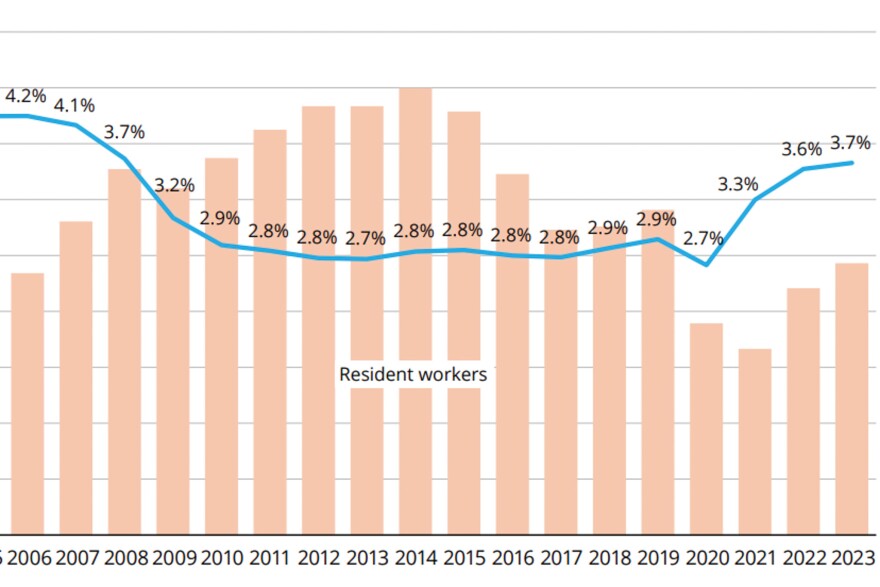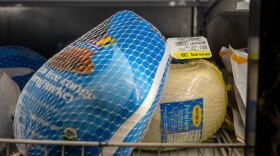On a recent Monday afternoon at Big Dipper Homemade Ice Cream in Palmer, Kodiak Fieser rang up a pint of Oatmeal Cream Pie. At 18, he’s on the older end of the typical worker at the shop.
Owner Rob Brown says roughly 80% of employees are teens.
“I'm a big fan of the teenage group,” he said.
Big Dipper has three locations in the Matanuska-Susitna Borough. They specialize in homemade flavors like “So Good It’s Cinnful,” a cinnamon ice cream swirled with cream cheese frosting and bits of homemade cinnamon rolls. Another incorporates locally made lingonberry jam. The shop was voted best ice cream in the borough in the 2025 Best of the Valley Awards.

Brown hires workers as young as 15 and pays them minimum wage, $13 dollars an hour plus tips. He said he couldn’t operate his business without teens – and he wouldn’t want to.
“They're at that stage in life where they like to be treated as adults, and they want to be given that opportunity, and they just need some guidance and some direction.” Brown said. “Most of them are willing to step up and take ownership, which is really cool.”
Through employment, Brown says teens learn valuable life skills, like personal responsibility, accountability and communication skills. And he said those traits are appreciated by customers.
“To me, as someone who's middle aged, and I go to some place and I have a young person treat me with respect and show they have proper manners, it gives me hope,” he said.
Teens are a growing segment of Alaska’s workforce, according to a recent report from the state’s Department of Labor and Workforce Development. Nearly 12,000 kids between 14 and 17 years old had a job in 2023, an increase of a full percentage point since 2020. Teens now make up 3.7% of the overall labor force in the state, the highest share since 2008.
The Coronavirus pandemic created a significant need for workers nationwide. Rob Kreiger, the state economist who wrote the report, said that opened doors for young people.
"Because of how the workforce changed after the pandemic, I think there’s just a lot more demand for the types of jobs that younger workers tend to have,” Kreiger said.
Over a third of working teens in Alaska had jobs in accommodation and food service, followed by retail trade and local government, at 18% and 9% respectively.

Alaska’s child labor law requires employees under 16 to file a work permit with the Department of Labor and Workforce Development. No minor can work more than six days a week and are limited to working 40 hours per week, or 23 hours during the school year. The laws are much stricter for kids 14 and 15 years old, and there’s a list of jobs minors can’t do.
Wages for teens surged about five-times the rate of the average state worker between 2019 and 2023, according to the study. As long as the labor shortage continues, Kreiger said it could mean more opportunities for young Alaskans.
“Because the demand is high, employers are in a position where they have to pay more. Although the types of occupations that younger workers have generally has been consistent over time, there may be more choices than there have been in years past.”
The Kusilvak and Hoonah-Angoon Census Areas had the highest concentrations of teen workers.
Many teenage workers are only employed during the summer, the report said, but not 17-year-old Hayden Postishek. He’s a student at Service High School in Anchorage, and has had a job for a few years.
“It instills some good habits. You understand that other people rely on you,” he said.
Postishek teaches swimming lessons in the summer at the Northern Lights Swim Club. In the winter, he teaches lessons at Hilltop Ski Area.
“I did a lot of those things when I was little. I remember how much I enjoyed doing them, and how much having a good instructor made the experience a lot more fun,” Postishek said. “I just try to be that fun instructor.”
Postishek learned to ski at Hilltop.

Other teens working at the small ski area have similar memories, said Robert DeBerry, the nonprofit’s director of marketing and community relations. Young people bring an enthusiastic spirit to the job that’s rooted in passion for the sport, he said.
“I think we're lucky in this industry, because we don't necessarily get the kids that are just looking for a job,” DeBerry said. “They come here to get the job because they want to work at Hilltop, they want to work in the industry, they want to ski, they want to snowboard. Let's face it, we deal in fun.”
At Hilltop in south Anchorage, teens are ski and snowboard instructors, manage equipment rentals, and handle ticket sales. Each of those positions start at $14 an hour, and come with a free season pass.
DeBerry said he’s been fortunate to have fulfilling jobs that don’t feel like work, and wants to give young people that same opportunity.
“I think a lot of young kids end up in careers or jobs that they just hate,” he said. “Why not give a kid an opportunity to have a job based around fun? Why not instill that pride in your job in young people, as well, at an early age?”







